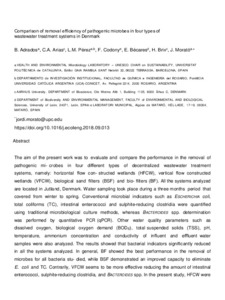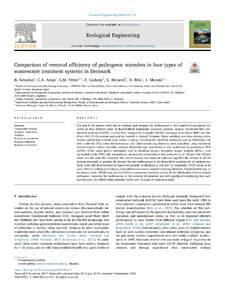Por favor, use este identificador para citar o enlazar este ítem:
https://repositorio.uca.edu.ar/handle/123456789/9529| Título: | Comparison of removal efficiency of pathogenic microbes in four types of wastewater treatment systems in Denmark | Autor: | Adrados, B. Arias, C. A. Pérez, Leonardo Martín Codony, F. Bécares, E. Brix, H. Morató Farreras, Jordi |
Palabras clave: | TRATAMIENTO DE AGUAS RESIDUALES; INGENIERIA SANITARIA; ANALISIS DEL AGUA | Fecha de publicación: | 2018 | Editorial: | Elsevier | Cita: | Adrados, B. et al. Comparison of removal efficiency of pathogenic microbes in four types of wastewater treatment systems in Denmark [en línea]. Ecological Engineering. 2018, 124. doi:10.1016/j.ecoleng.2018.09.013 Disponible en: https://repositorio.uca.edu.ar/handle/123456789/9529 | Resumen: | Abstract: The aim of the present work was to evaluate and compare the performance in the removal of pathogenic microbes in four different types of decentralized wastewater treatment systems, namely: horizontal flow constructed wetlands (HFCW), vertical flow constructed wetlands (VFCW), biological sand filters (BSF) and biofilters (BF). All the systems analyzed are located in Jutland, Denmark. Water sampling took place during a three months period that covered from winter to spring. Conventional microbial indicators such as Escherichia coli, total coliforms (TC), intestinal enterococci and sulphite-reducing clostridia were quantified using traditional microbiological culture methods, whereas Bacteroides spp. determination was performed by quantitative PCR (qPCR). Other water quality parameters such as dissolved oxygen, biological oxygen demand (BOD5), total suspended solids (TSS), pH, temperature, ammonium concentration and conductivity of influent and effluent water samples were also analyzed. The results showed that bacterial indicators significantly reduced in all the systems analyzed. In general, BF showed the best performance in the removal of microbes for all bacteria studied, while BSF demonstrated an improved capacity to eliminate E. coli and TC. Contrarily, VFCW seems to be more effective reducing the amount of intestinal enterococci, sulphite-reducing clostridia, and Bacteroides spp. In the present study, HFCW were the less efficient wastewater treatment system for the elimination of the evaluated pathogens. However, the performance in the removal of microbes was still significant considering that such systems were the oldest under operation (with over 20 years of continuous task). | URI: | https://repositorio.uca.edu.ar/handle/123456789/9529 | ISSN: | 0925-8574 | Disciplina: | INGENIERIA AMBIENTAL | DOI: | 10.1016/j.ecoleng.2018.09.013 | Derechos: | Acceso abierto. 24 meses de embargo | Fuente: | Ecological Engineering. 2018, 124 |
| Aparece en las colecciones: | Artículos |
Ficheros en este ítem:
| Fichero | Descripción | Tamaño | Formato | |
|---|---|---|---|---|
| comparison-removal-efficiency-pathogenic.pdf | 923,18 kB | Adobe PDF |  Visualizar/Abrir | |
| thumb.jpg | 777,66 kB | JPEG |  Visualizar/Abrir |
Visualizaciones de página(s)
209
comprobado en 30-abr-2024
Descarga(s)
349
comprobado en 30-abr-2024
Google ScholarTM
Ver en Google Scholar
Altmetric
Altmetric
Este ítem está sujeto a una Licencia Creative Commons

